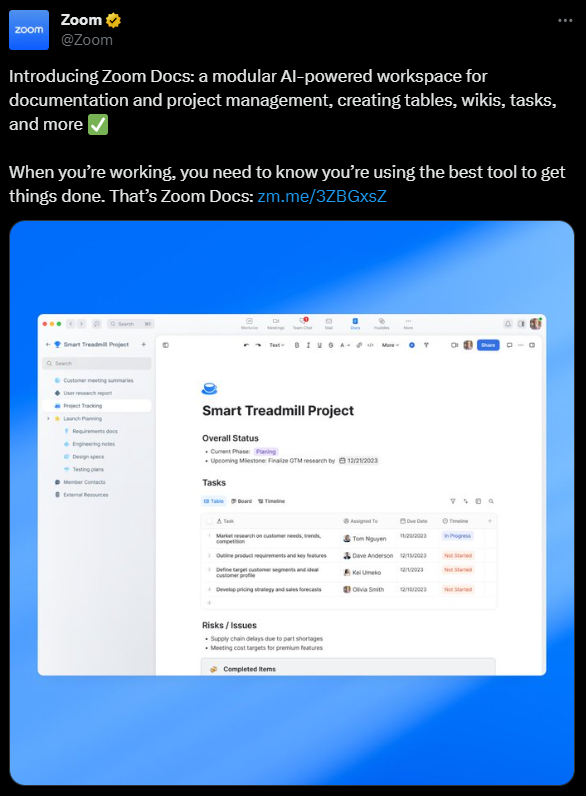
Zoom’s new AI-powered ‘modular workspace’ to compete with Microsoft. (Source – AFP)
Zoom update: Can its new AI ‘modular workspace’ compete with Microsoft’s?
- The latest update from Zoom unveils AI-powered Zoom Docs amid financial growth and Microsoft rivalry.
- Zoom expands with AI tools and office services, maintaining its video conferencing lead.
- Will the new Zoom update be enough to worry the likes of Microsoft Teams, though?
As Zoom seeks to stand toe-to-toe with giants like Google and Microsoft, the highlight of its annual Zoomtopia 2023 event was the unveiling of Zoom Docs. This new offering is Zoom’s rendition of an AI-enhanced “modular workspace,” designed to furnish users with state-of-the-art AI tools that can draft, modify, condense, and incorporate insights directly from their meetings.
The “modular workspace” here essentially means a setup that allows you to have a flexible and efficient home office or workspace for virtual meetings on the Zoom platform.
Diving deeper into Zoom Docs, one finds it isn’t merely another document processor. It combines conventional document-editing capabilities with advanced features like wikis and a highly intuitive drag-and-drop interface for charts, tables, and visual content. What’s more, the AI prowess of Zoom Docs lets users auto-populate documents with content drawn from Zoom Meetings. This helps both initiate and enrich the document creation process through quick content summaries, easy document searches, or generating content via the Zoom AI Companion. Its broad-scale release is expected in 2024.
Eric S. Yuan, the founder and CEO of Zoom, said the company was “grounded in doing what’s right and caring for our customers. We understand that business leaders are faced with new obstacles every day — whether it’s navigating hybrid work, improving engagement and collaboration among customers and employees, deciding how to leverage generative AI to empower people, or reducing the complexity of their IT solutions.”
A report from Bloomberg focuses on the tool’s ability to integrate AI-curated summaries and insights directly from Zoom meetings seamlessly. Smita Hashim, Zoom’s chief product officer, emphasized this facet of the new offering.
Financial projections and expansion beyond video conferencing
Reflecting on Zoom’s financial trajectory, its revenue has skyrocketed between 2020-2022, multiplying over five times to reach US$4.1 billion. This boom can be attributed to Zoom’s pivotal role during the global pandemic. However, the inevitable post-pandemic transition saw offices reopening, leading to stiffer competition. Consequently, experts forecast a modest sub-2% surge in sales in upcoming quarters. Zoom’s blueprint for invigorating growth hinges on diversifying its toolkit beyond video conferencing.

Zoom introduces Zoom Docs in new company update. (Source – X)
In today’s age of flexible work environments, Zoom believes in curating employee experiences tailored to varied work preferences. In line with this, Zoom showcased its latest platform enhancements at Zoomtopia too. Notably, the acquisition of Workvivo earlier this year stands out. Workvivo, an employee engagement and communication solution, promises innovative avenues to keep employees attuned, active, and interconnected in the present-day flexible work paradigm.
Zoom further emphasized the importance of a robust, continuous engagement strategy for today’s global workforce. As a testament to this commitment, in the ensuing weeks, Workvivo will be directly accessible within the familiar Zoom desktop interface.
Embracing generative AI for enhanced experiences in a new Zoom update
Generative AI’s mention in tech news has become almost a daily occurrence, and Zoom’s narrative is no exception. The company has underlined its advances in harnessing AI, especially to enhance customer experiences. Zoom’s AI-centric solutions, like its AI Expert Assist, are tailored to fortify customer-facing teams, ensuring they have a consolidated toolkit to bolster customer interactions, irrespective of their geographical setting.
Zoom’s venture into office phone services has borne fruit, raising approximately US$500 million annually. In addition, its customer service center initiative has already surpassed 500 clientele. The figures are promising, as Morgan Stanley’s analyst Meta Marshall confirmed. However, Zoom remains reticent about divulging engagement statistics for some of its newer tools, like the email and calendar services launched last year.
Battling giants and market shares
Microsoft’s Teams continues to cast a long shadow as a significant competitor though. Over the past year, Zoom has engaged with regulatory bodies from the US and the European Union, raising concerns over Microsoft’s predilection for favoring its products via design nuances and pricing packages. This sentiment was echoed by Zoom CEO, Eric Yuan, who in September proposed that US regulatory authorities scrutinize the matter in depth.
Many within Zoom’s executive ranks and a significant number of financial market observers believe that the general populace prefers Zoom’s videoconferencing interface over Teams. Yet, when one delves into the market shares, Zoom claims merely around 7% of the communications and collaboration software domain as of the year’s first quarter. In stark contrast, Microsoft soars to 42%, according to data from industry analyst IDC.
Hashim – as you’d expect from the company’s product officer – praised Zoom’s performance as a tool, claiming it stood head and shoulders above its competition for quality, despite its moribund market share.
In its quest to maintain this position as a quality offering, Zoom is dabbling with some intriguing functionalities, as shown by its recent patent applications. One such approved patent from this year reveals Zoom’s endeavors to infuse meetings with interactive virtual entities, targeting arenas like product promotion and educational endeavors.
Another intriguing patent hints at a tool that interprets the “nonverbal cues” of attendees, possibly nudging the host to engage someone who appears eager to contribute. Speaking about Zoom’s innovation thrust, Hashim lauded its technical teams but remained tight-lipped about particular patent details.
Last September, Zoom rolled out AI-driven functionalities, notably the capability to succinctly summarize calls and assist in drafting messages. These cutting-edge tools are seamlessly incorporated into its premium packages, sans any additional charges. Hashim reinforced this move by clarifying that this wasn’t a temporary price waiver. Instead, Zoom claims it is resolute in offering these AI enhancements to its user base as part of existin packages.
Commenting on Zoom’s continual evolution beyond mere meeting tools, Hashim noted, “We are beginning to see that customer interest and customer adoption continues to go up. The focus right now is bringing more and more value to customers through these kind of cross-product journeys.”
That’s as may be, but will the latest Zoom update be enough to put it where it wants to be – ever closer to competing with the big league of tech giants? Only time, customer adoption, market share and revenue will tell.
READ MORE
- Safer Automation: How Sophic and Firmus Succeeded in Malaysia with MDEC’s Support
- Privilege granted, not gained: Intelligent authorization for enhanced infrastructure productivity
- Low-Code produces the Proof-of-Possibilities
- New Wearables Enable Staff to Work Faster and Safer
- Experts weigh in on Oracle’s departure from adland




